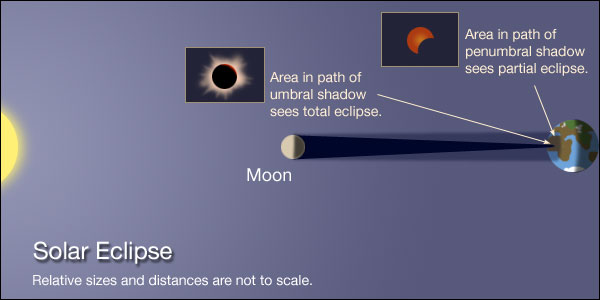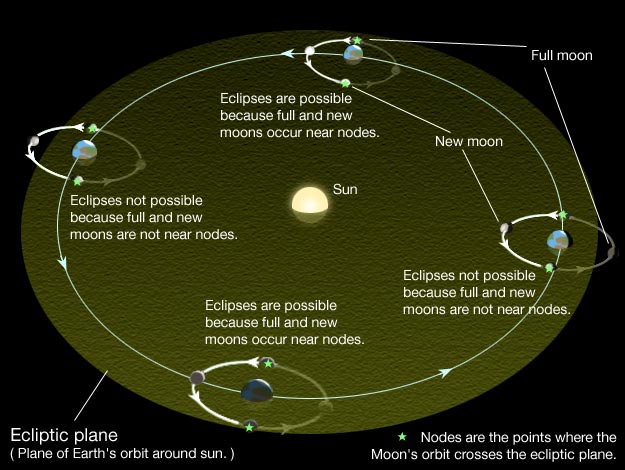Unlike day and night, the phases of the Moon, and the seasons, this last phenomenon is a rare event that you may or may not have personally experienced or listed on your set of observations. This may have just changed as of August, 2017, as many of us got to experience the solar eclipse that passed through much of the US! Eclipses occur infrequently because they require a very specific alignment of the Sun, Earth, and Moon. If the Moon is lined up precisely with the Sun from the Earth’s point of view, the Moon will block Sunlight from reaching the Earth, causing a solar eclipse. If the Moon is on the other side of the Earth from the Sun, the Earth will block Sunlight from reaching the Moon, causing a lunar eclipse. According to the diagram of the Moon phases from the Lunar Cycles module, it appears that the Sun, Earth, and Moon are lined up for an eclipse twice a month!
Is there a solar eclipse every new Moon and a lunar eclipse every full Moon?
As it turns out, there is another effect that we need to account for. In order for there to be an eclipse during every full Moon and new Moon, the orbital plane of the Moon around the Earth would have to be identical to the orbital plane of the Earth around the Sun. That is, the three objects have to be precisely lined up as in the first diagram below. If, for example, the Moon is above or below the Earth’s shadow, there will not be a lunar eclipse. Similarly, if the Moon’s shadow does not hit the Earth because the Moon is above or below the plane of the Earth’s orbit around the Sun, there will not be a solar eclipse. The plane of the Moon’s orbit is inclined by 5 degrees compared to the plane of the Earth’s orbit, so at most times the Moon is above or below the position necessary to cause an eclipse.
If you think of the Earth’s orbit around the Sun as a disk and the Moon’s orbit around the Earth as another disk, there is a 5 degree angle between the two disks. However, any time you have two circles that intersect each other like the two disks do, there will be two points at which the intersection occurs (just like the two equinoxes we discussed above are the two points where the Celestial Equator and Ecliptic intersect). These two points on the Moon’s orbit (where the Moon lies in the same plane as the Earth’s orbit) are called nodes, and the line connecting these two points is called the line of nodes.
So, the recipe for having a solar or lunar eclipse requires two circumstances, not just one. They are:
- The phase of the Moon must be new for a solar eclipse or full for a lunar eclipse to occur (top figure).
and - The line of nodes must be closely aligned with the Sun and the Earth (bottom figure).


Watch This!
You can find a brief video clip about a solar eclipse at the Teachers' Domain website.
NOTE: "Teacher's Domain" is a free resource, but you must register with them in order to view more than 7 resources. Since we'll point to that resource throughout this course, you may want to take a moment to go ahead and register with them now.
The appearance of the Sun and Moon during eclipses
Finally, let’s conclude this lesson with a discussion of how the Sun and Moon appear during eclipses. There are three possibilities for a lunar eclipse, depending on how well the line of nodes is aligned with the Sun and Earth:
- Total Lunar Eclipse: Occurs when the Moon is entirely contained within the Earth’s umbra.
- Partial Lunar Eclipse: Occurs when the Moon is partly in the umbra of the Earth and partly in the penumbra.
- Penumbral Lunar Eclipse: Occurs when the Moon is entirely contained within the penumbra.
During a total lunar eclipse, the Moon will darken considerably and glow red as the Earth allows some of the red light from the Sun to reach the Moon. During a partial lunar eclipse, part of the Moon will appear darker and redder, while the rest will appear normal. Most of us don’t even notice penumbral lunar eclipses, because the Moon only dims.
Here are some examples:
- Astronomy Picture of the Day: 2003 November 21
- Astronomy Picture of the Day: 2001 January 18
- Astronomy Picture of the Day: 2003 May 22
One significant difference between solar and lunar eclipses that we must mention is that a solar eclipse is only visible to certain parts of the Earth. See these Astronomy Pictures of the Day to see why:
There are three types of solar eclipses, too:
- Total Solar Eclipse: Anyone on Earth who lives in an area where the Moon’s umbra passes will see the entire Sun obscured by the Moon. For example: Astronomy Picture of the Day: 2002 December 6. Many of you have probably heard this, but people who have experienced a total solar eclipse describe it as one of the most breathtaking phenomena in their lives. It is almost impossible to capture in images or videos the effects, but there are a number of very interesting aspects of total solar eclipses that awe the people who see them. For example, here is an image of the "Diamond Ring" effect just after totality during the August 21, 2017 eclipse. The next total solar eclipse that will be visible in the US is in April of 2024. Here is a Google map of the eclipse path. This course's author stayed in PA for the 2017 eclipse, but will be traveling to the path of totality for the 2024 eclipse and encourages all of you to do the same!
- Partial Solar Eclipse: If you live just outside the path of the Moon’s umbra, but within the path of the Moon’s penumbra, you will see part of the Sun obscured by the Moon. Here is a good example: Astronomy Picture of the Day: September 3, 1997. There are many images like this from the August 2017 eclipse.
- Annular Solar Eclipse: Recall from the movie of the lunation above that the Moon appears to be a little bit bigger sometimes and a little bit smaller other times. This is caused by the Moon’s elliptical orbit. Sometimes it is closer to the Earth than other times. Well, if the Moon just happens to be in a position that is slightly farther from Earth, it won’t completely cover the Sun even during a total solar eclipse. In this case, you see a ring of the Sun still visible, such as in this example: Astronomy Picture of the Day: 2003 June 5.